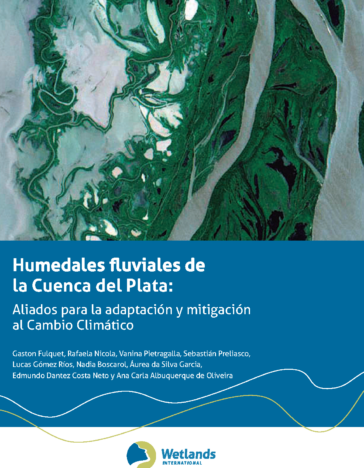
Plata Basin Wetlands: Natural Allies in Facing Climate Change
The Paraguay and Paraná rivers are part of the Plata Basin, which contains the largest continuous corridor of riverine wetlands in the world and underpins 70% of the GDP of the five countries that share this territory.
These wetlands are natural allies for both mitigating and adapting to the effects of climate change, which is already impacting the region through increasingly severe and frequent extreme weather events.
Thanks to their capacity to capture and store carbon, they help reduce the concentration of greenhouse gases in the atmosphere, directly contributing to climate change mitigation. In addition, they provide a natural buffer against droughts, floods and storms—essential for climate adaptation.
Despite their irreplaceable role as sources of life and biodiversity, these ecosystems have lost up to 22% of their global surface since the 1970s due to human activity—a figure that rises to 59% in Latin America.
In this context, Argentina has just presented its new Nationally Determined Contribution (NDC) with lower targets. This makes it even more critical to protect this vast fluvial corridor—the last free-flowing one of its kind in the world—to ensure the ecological health and economic wellbeing of the region.
“Plata Basin Riverine Wetlands: Allies for Climate Adaptation and Mitigation,” the new publication from Fundación Humedales / Wetlands International, is the first study to clearly demonstrate the fundamental role these ecosystems play in responding to planetary warming. The report arrives at a key moment: the start of COP30 in Belém, Brazil, where government representatives, the private sector and civil society will seek to advance coordinated climate policies, financing, and the energy transition.
Natural Filters
Wetlands provide 40% of all socio-ecological functions delivered by ecosystems worldwide, generating countless benefits: they improve air quality, purify water, host biodiversity, and offer landscapes of remarkable beauty, while supporting livelihoods and job creation.
In wetlands, water is the defining element. “The clearest example of the contributions of these ecosystems is their ability to naturally filter the water carried by rivers. The hydrological connectivity between rivers and floodplain wetlands is essential for improving water quality,” explained Gastón Fulquet, Regional Coordinator of the Blue Corridor Program at Fundación Humedales / Wetlands International.
High-quality water supports a wide range of regional productive activities, including fishing, agriculture, livestock and forestry, as well as being a key input for industrial and extractive processes such as mining. It is no coincidence that Argentina’s main agricultural, industrial and port corridor lies along the Paraná River and its delta.
Climate Change Impacts
Climate change is already being felt in the region. The report explains how wetlands along the Paraguay-Paraná corridor store excess water during major floods and release it slowly during dry periods, acting as natural firebreaks during prolonged droughts.
Argentina’s Litoral region, particularly the Paraguay-Paraná system, is already experiencing these extreme events—prolonged droughts, historic low water levels, wetland fires, declining water quality and loss of ecological connectivity.
“These events show that climate change is intensifying existing pressures on Litoral wetlands and demands stronger multi-level governance,” said Enrique Estévez, Minister of Environment and Climate Change of Santa Fe province.
Shared Responsibility
Wetlands receive less global attention than other ecosystems, despite being the ecosystem suffering the fastest rate of loss. “Good ecosystem governance requires collaborative approaches: the state must lead and coordinate with civil society and the private sector. Through the Blue Corridor Program, we have made significant contributions in both Argentina and Brazil,” Fulquet noted.
In Argentina, the Blue Corridor Program has supported progress on the National Wetlands Inventory, mapping more than 35,000 km² of wetlands along the lower and middle Paraná Basin. These inventories are key tools for assessing the conservation status of wetlands and for land-use planning that considers hydrological risk.
In Brazil, the program has contributed to strengthening early warning and anticipatory action systems for drought prediction and mitigation, and helped develop the Fire Intelligence System for Wetlands (SIFAU) in collaboration with universities and subnational environmental authorities in the Pantanal.
Subnational governments play a crucial role, especially when national priorities shift. Santa Fe, with nearly 800 km of shoreline along the Paraná, has advanced several measures:
“In a context of limited national climate prioritization, subnational governments are adopting regional cooperation strategies, policy coordination and innovative approaches such as institutionalizing watershed-based management aligned with programs like the Blue Corridor,” Estévez added.
For healthy wetlands to persist, local communities must be at the center: “Living here means having technical knowledge and daily understanding of the wetland, the islands and the river. We never see this territory as something outside ourselves—we feel it as an extension of our bodies,” said Soledad Ferrerías, from Taller Flotante in Victoria, Entre Ríos.
She warns that the ecological crisis in the Paraná Delta is serious: “This last low-water cycle, which continues, is not just part of natural pulses. These are unprecedented changes linked to human activity.” From her perspective, community organizations play a central role in protecting nature through self-managed projects in environmental planning, education, culture and production.
With COP30 returning to Latin America after more than a decade, this is a key opportunity to recognize wetlands as the most powerful nature-based solution the region has to offer in facing the global climate crisis—benefiting the more than 100 million people who depend on and enjoy them every day.

